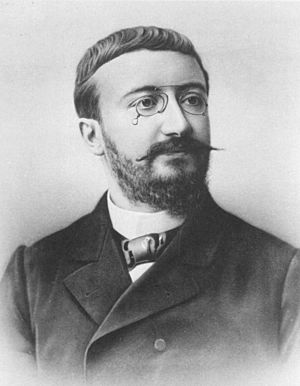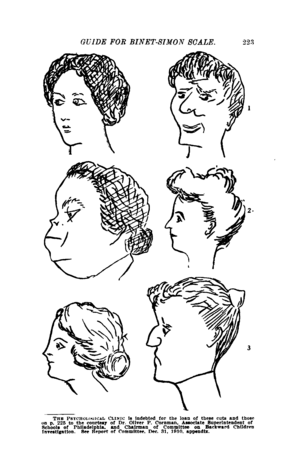Alfred Binet facts for kids
Quick facts for kids
Alfred Binet
|
|
|---|---|

Alfred Binet
|
|
| Born | 8 July 1857 |
| Died | 18 October 1911 (aged 54) Paris, France
|
| Nationality | French |
| Known for | Stanford–Binet Intelligence Scales Binet–Simon test |
| Spouse(s) | Laure Balbiani |
| Scientific career | |
| Fields | Psychology |
| Influences | John Stuart Mill |
| Influenced | Jean Piaget |
Alfred Binet (8 July 1857 – 18 October 1911) was a French psychologist. He is famous for creating the first useful IQ test. This test is known as the Binet–Simon test.
In 1904, the French government asked Binet for help. They wanted a way to find students who were struggling in school. This way, these students could get extra help. Binet worked with his friend Théodore Simon. They published new versions of their test in 1908 and 1911. The last version came out just before Binet passed away.
Contents
About Alfred Binet
Early Life and Studies
Alfred Binet was born as Alfredo Binetti in Nice. At that time, Nice was part of the Kingdom of Sardinia. It became part of France in 1860. Binet came from a Jewish family, but he did not practice the Jewish faith.
Binet studied law in Paris and got his degree in 1878. He also studied how the body works (physiology) at the Sorbonne. His first job was at a hospital in Paris called Salpêtrière Hospital. He worked there as a researcher from 1883 to 1889.
Later, Binet became a researcher and assistant director at the Laboratory of Experimental Psychology at the Sorbonne. He worked there from 1891 to 1894. In 1894, he became the director of the laboratory. He held this job until he died in 1911. Binet also learned a lot by reading psychology books at the National Library in Paris.
Learning from Early Research
In 1883, Binet met Charles Féré, who introduced him to Jean-Martin Charcot. Charcot was the director of the La Salpêtrière clinic. Charcot became Binet's teacher. Binet took a job in Charcot's lab.
At that time, Charcot was experimenting with hypnotism. Binet was influenced by Charcot and wrote about his work on hypnotism. He strongly supported Charcot's ideas. However, Charcot's findings were later found to be incorrect. Binet had to publicly admit he was wrong. Even so, his name became known in the field of psychology.
After his work with hypnotism did not succeed, Binet changed his focus. He started studying how children develop. This was inspired by his two daughters, Marguerite and Alice, who were born in 1885 and 1887. Binet studied his daughters closely. This helped him understand more about intelligence. He especially learned about how attention and being easily influenced (suggestibility) play a role in how smart someone becomes.
Binet published over 200 books and articles in different areas of psychology. His work may have influenced Jean Piaget. Piaget later studied with Binet's helper, Théodore Simon.
Creating the Binet–Simon Test
In 1899, Binet joined a group called the Free Society for the Psychological Study of the Child. French schools were changing a lot then. A new law made it mandatory for children aged six to fourteen to attend school. This group wanted to study children in a scientific way.
Binet and other members of the group were asked to help children with learning difficulties. The main question was: "What kind of test should we give to children who might have learning disabilities?" Binet decided to find a way to measure the differences between typical children and those who needed extra help. He described his methods in a book published in 1903.
Soon after, Binet started developing more tests. He worked with a young medical student named Theodore Simon. Simon became Binet's research assistant. Together, they created the intelligence tests that Binet is famous for.
In 1905, they introduced a new test called the Binet–Simon scale. They improved the test in 1908. They removed some questions, changed others, and added new ones. They also organized the questions by age levels, from three to thirteen years old.
The French government asked a group of child psychologists to help identify students who needed special education. Binet was an active member of this group. This gave him the push to create his mental scale.
Binet and Simon created tasks that they thought typical children could do at different ages. They had watched children for many years and used their own research. They tested their scale on 50 children. These children were identified by their teachers as being average for their age. The goal was to compare a child's mental abilities to those of other children their age.
The test had 30 tasks that got harder and harder. The easiest tasks could be done by everyone. For example, some simple tasks checked if a child could follow a light or talk to the examiner. Slightly harder tasks asked children to point to body parts, repeat numbers, or define words like "house." More difficult tasks asked children to find differences between things or make sentences from given words. The hardest tasks included repeating seven random numbers or solving riddles.
The score on the Binet-Simon scale showed a child's mental age. For example, if a 6-year-old child passed all the tasks that 6-year-olds usually passed, their mental age would be 6.0.
Binet was clear about the limits of his test. He said that intelligence is very diverse. He also believed that intelligence can change and be affected by a child's environment. This meant that intelligence was not just based on genetics. It could grow and change. He also said the test should only be used for children with similar backgrounds.
The Test in the U.S.
In the U.S., leaders were looking for ways to help a growing and changing population. In 1908, a man named Henry H. Goddard brought the Binet-Simon Scale to the United States. He translated it into English.
Later, Lewis Terman took the Binet-Simon Scale and made it standard for a large American group. This new test was called the Stanford-Binet scale. Binet's original goal was to help all children get an education. However, in the U.S., the test was sometimes used for different purposes.
Binet did not travel outside France much. His test was not widely used in his own country during his lifetime. When he learned that his test was being used in ways he did not intend, he spoke out. He criticized those who used his test to label intelligence as a single, unchanging thing.
Binet studied children from 3 to 18 years old. He published the third version of the Binet-Simon scale shortly before he died in 1911. The Binet-Simon scale became very popular worldwide. This was because many studies were based on it, and it was easy to use.
After his death, Binet was honored in several ways. In 1917, the Free Society for the Psychological Study of the Child changed its name to La Société Alfred Binet. This was to remember the famous psychologist. In 1984, the journal Science 84 named the Binet-Simon scale as one of the most important discoveries of the century.
Binet also wrote several plays for the Grand Guignol theatre. He also studied the abilities of a famous palm reader in Paris, Valentine Dencausse.
Binet and Chess
Binet did experiments to see how well chess players could play when blindfolded. He found that some master chess players could play from memory. A few could even play many games at once without looking at the boards.
To remember the chess pieces, some players imagined exact copies of chess sets. Others thought of the game in a more abstract way. Binet concluded that amazing memory skills, like playing blindfolded chess, could happen in different ways. He wrote about his experiments in a book called Psychologie des grands calculateurs et joueurs d'échecs.
See also
 In Spanish: Alfred Binet para niños
In Spanish: Alfred Binet para niños


